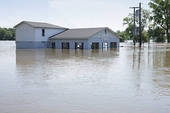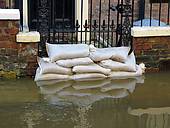Flood Insurance and Property Protection
Over the life of a 30-year mortgage, a home in a Special Flood Hazard Area (SFHA) has about a 3 times greater chance of having a flood than a fire. But anywhere it rains, there is a possibility of flooding. Every year, 25% of flood insurance claims are from outside the SFHA.
Standard homeowners insurance or business insurance does not cover flood damage.

In 1968, Congress created the National Flood Insurance Program (NFIP) to provide flood insurance protection to property owners in return for local government commitment to sound floodplain management. Richland County has participated in the NFIP since 1979.
The NFIP insures buildings, including mobile homes, with two types of coverage:
- Structural coverage for walls, floors, insulation, furnace, and other items permanently attached to the structure.
- Contents coverage may be purchased separately providing the contents are in an insurable building.
Who needs flood insurance?
Facts to remember when asking this question:
- Everyone lives in a flood zone, it’s the risk that varies.
- Most homeowners insurance doesn’t cover flood damage.
- You can purchase flood insurance no matter what your risk.
- There is a 26% chance of experiencing flood damage during a standard 30-year mortgage.
- Just because a flood has never happened at your home, it doesn’t mean it won’t happen.
- There is a low-cost policy for homes in low to moderate flood risk areas offered through the NFIP.
Mandatory Purchase Requirement
The Flood Disaster Protection Act of 1973 and the National Flood Insurance Reform Act of 1994 mandate that federally regulated, supervised, or insured financial institutions and Federal Agency lenders require flood insurance for buildings located in a participating NFIP community and in a Special Flood Hazard Area (SFHA). Some financial institutions may require flood insurance for properties outside a SFHA for their own risk management process.

How can I protect my property?
In addition to flood insurance you can also take some protective measures to prevent floods from damaging you property and belongings. FEMA recommends six ways to protect your house from flooding.

- Elevation is raising your house so that the lowest floor is above flood level. This is the most common way to avoid flood damage.
- Wet floodproofing makes uninhabited parts of your house resistant to flood damage when water is allowed to enter during flooding.
- Relocation means moving your house to higher ground where the exposure to flooding is eliminated altogether.
- Dry floodproofing is sealing your house to prevent flood waters from entering.
- Levee and floodwall protection means constructing barriers to prevent flood waters from entering your house.
- Demolition means razing your house and rebuilding properly on the same property or buying a house elsewhere.
Additional Resources
For More information on protective measures, FEMA has the following free publications to assist in retrofitting:
Homeowner's Guide to Retrofitting
Above the Flood: Elevating your Flood prone House
Design Manual for Retrofitting Flood prone Residential Structure
Always remember to contact the building inspector or floodplain coordinator before beginning any retrofitting projects. Local officials know the retrofitting methods that meet state and local government requirements. Local officials can also help guide you to possible financial assistance for retrofitting projects. Financial assistance means loans, grants, and insurance payments. For example, under FEMA's National Flood Insurance Program, a policy holder may qualify for Increased Cost of Compliance (ICC) coverage. If your house is substantially damaged by flooding, ICC coverage may help pay for some types of retrofitting.